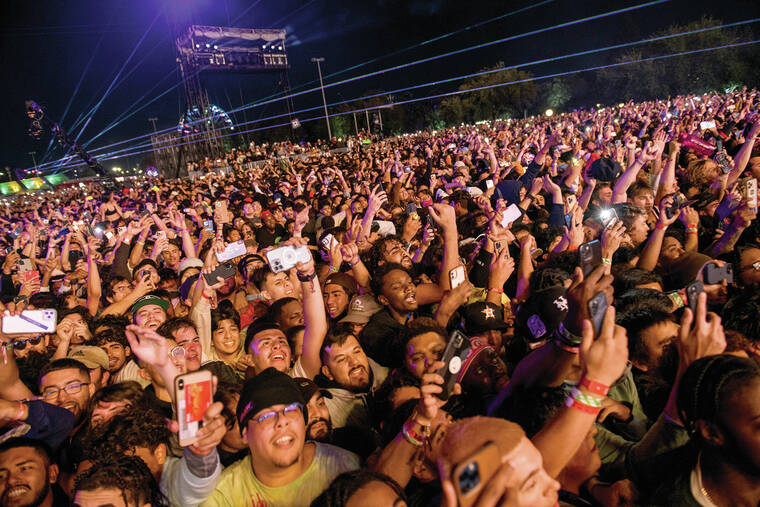HOUSTON — The crowd at a Houston music festival suddenly surged toward the stage during a performance by rapper Travis Scott, squeezing fans so tightly together that they could not breathe or move their arms and killing eight people in the chaos.
The pandemonium unfolded Friday evening at Astroworld, a sold-out, two-day event in NRG Park with an estimated 50,000 people in attendance. As a timer clicked down to the start of the performance, the crowd pushed forward.
“As soon as he jumped out on the stage, it was like an energy took over and everything went haywire,” concertgoer Niaara Goods said. “All of a sudden, your ribs are being crushed. You have someone’s arm in your neck. You’re trying to breathe, but you can’t.”
Goods said she was so desperate to get out that she bit a man on the shoulder to get him to move.
The dead ranged in age from 14 to 27, and 13 people were still hospitalized Saturday, Mayor Sylvester Turner said. He called the disaster “a tragedy on many different levels” and said it was too early to draw conclusions.
“It may well be that this tragedy is the result of unpredictable events, of circumstances coming together that couldn’t possibly have been avoided,” said Judge Lina Hidalgo, Harris County’s top elected official. “But until we determine that, I will ask the tough questions.”
Experts who have studied deaths caused by crowd surges say they are often a result of density — too many people packed into a small space. The crowd is often running either away from a perceived threat or toward something they want, such as a performer, before hitting a barrier.
G. Keith Still, a visiting professor of crowd science at the United Kingdom’s University of Suffolk, has testified as an expert witness in court cases involving crowds. He said he usually does not look at eyewitness reports in the early stages of analyzing an incident because emotions can cloud the picture, and witnesses can see only what’s immediately around them.
Based on fire codes, the venue could have held 200,000 people, but city officials limited the attendance to 50,000, Houston Fire Chief Samuel Peña said.
“It was the crowd control at the point of the stage that was the issue, especially as the crowd began to surge toward the stage,” Peña said.
The deaths called to mind a 1979 concert by the Who where 11 people died as thousands of fans tried to get into Cincinnati’s Riverfront Coliseum. Other past crowd catastrophes include the deaths of 97 people in an overcrowded Hillsborough Stadium in 1989 in Sheffield, England, and numerous disasters connected with the annual hajj in Saudi Arabia.
People in the Houston crowd reported lots of pushing and shoving during the performances leading up to Scott’s set.
Then when Scott took the stage, the crowd seemed to rush to the front, trying to get closer to the stage, said Nick Johnson, a high school senior from the Houston suburb of Friendswood who was at the concert.
“Everyone was passing out around you, and everyone was trying to help each other. But you just couldn’t move. You couldn’t do anything. You can’t even pick your arms up,” Johnson said. “It just got worse and worse.”
Johnson said fans started to crush each other, and people started screaming. He said it felt like 100 degrees in the crowd. Scott seemed to be aware that something was going on in the crowd, but he might not have understood the severity of the situation, Johnson said.
In a tweet posted Saturday, Scott said he was “absolutely devastated by what took place last night.” He pledged to work “together with the Houston community to heal and support the families in need.”



